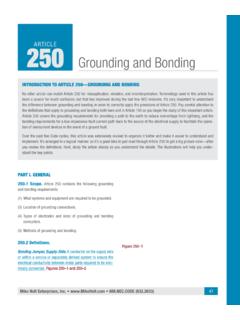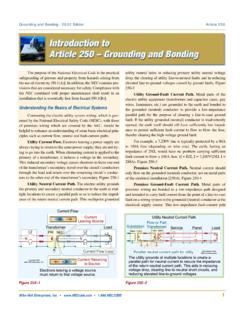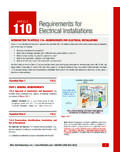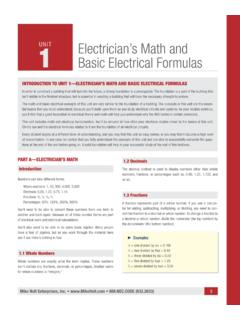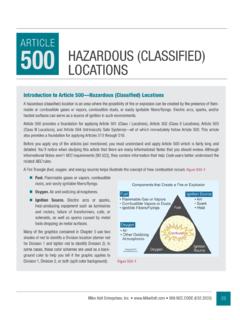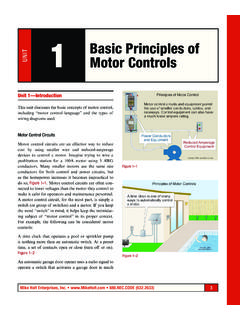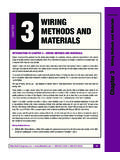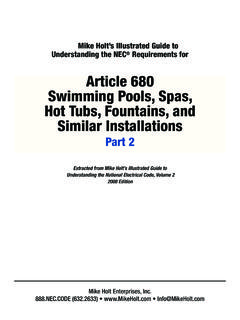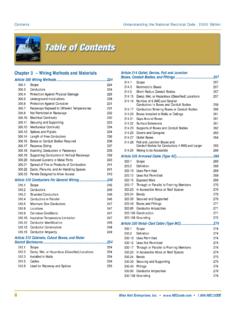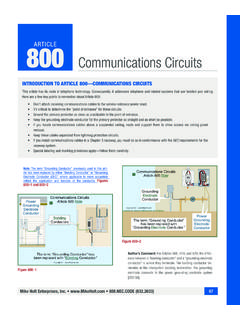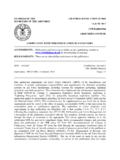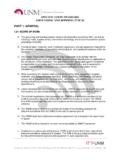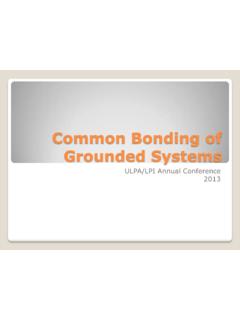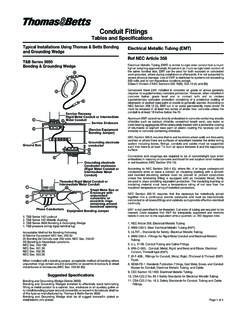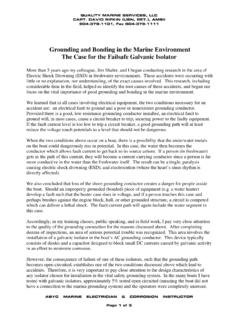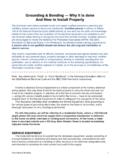Transcription of ARTICLE 250 GROUNDING AND BONDING - mikeholt.com
1 Mike Holt Enterprises ( )55 ARTICLE250 GROUNDING AND BONDINGI ntroduction to ARTICLE 250 GROUNDING and BondingNo other ARTICLE can match ARTICLE 250 for misapplication, violation, and misinterpretation. Terminology used in this ARTICLE has been a source for much confusion, but that s improved during the last few NEC revisions. It s very important to understand the difference between GROUNDING and BONDING in order to correctly apply the provisions of ARTICLE 250. Pay careful attention to the definitions that apply to GROUNDING and BONDING both here and in ARTICLE 100 as you begin the study of this important ARTICLE .
2 ARTICLE 250 covers the GROUNDING requirements for providing a path to the earth to reduce overvoltage from lightning, and the BONDING requirements for a low-impedance fault current path back to the source of the electrical supply to facilitate the oper-ation of overcurrent protection devices in the event of a ground the past several Code cycles, this ARTICLE was extensively revised to organize it better and make it easier to understand and implement. It s arranged in a logical manner, so it s a good idea to just read through ARTICLE 250 to get a big picture view after you review the definitions.
3 Next, study the ARTICLE closely so you understand the details. The illustrations will help you under-stand the key I. ScopeArticle 250 contains the following GROUNDING and BONDING requirements:(1) What systems and equipment are required to be grounded.(3) Location of GROUNDING connections.(4) Types of electrodes and sizes of GROUNDING and BONDING conductors.(5) Methods of GROUNDING and DefinitionBonding Jumper, Supply-Side. The conductor on the supply side of the service or separately derived system overcurrent protection device that ensures electrical conductivity between metal parts and the grounded conductor.
4 }Figure 250 1, }Figure 250 2, and }Figure 250 3 SCH 80 BONDING Jumper, Supply-Side, DefinitionSupply-SideBonding JumperCopyright 2017, theserviceovercurrentprotectiondevicetha tensureselectricalconductivitybetweenmet alpartsrequiredto beconnected.}Figure 250 1 Mike Holt s Illustrated Guide to Understanding 2017 NEC Requirements for BONDING and GROUNDING | GROUNDING and BondingAuthor s Comment:n System GROUNDING helps reduce fires in buildings as well as voltage stress on electrical insulation, thereby ensuring longer insulation life for motors, transformers, and other system components.
5 }Figure 250 5 Note 1: To limit imposed voltage, the GROUNDING electrode conductors shouldn t be any longer than necessary and unnecessary bends and loops should be avoided. }Figure 250 6 Performance Requirements for GROUNDING and BONDING (A) Solidly Grounded this QR code for a video of Mike explaining this topic; it s a sample from the DVDs that accompany this textbook.(1) electrical System GROUNDING . electrical power systems are grounded (connected to the earth) to limit the voltage induced by lightning, line surges, or unintentional contact by higher-voltage lines.
6 }Figure 250 4 2017 CCTransformerTransformerDisconnectCopyri ght 2017, :EquipmentGroundingConductor:GroundingEl ectrodeConductorGEC: SystemBondingJumperSBJ:Supply-SideBondin gJumperSSBJN:NeutralLegendTheconductoron thesupplysideof theseparatelyderivedsystemovercurrentpro tectiondevicethatensureselectricalconduc tivitybetweenmetalpartsrequiredto Jumper, Supply-Side, Definition}Figure 250 2 electrical System (A)(1)Electricalpowersystemsaregrounded( connectedtotheearth)tolimitthevoltageind ucedbylightning,linesurges,or 2017, }Figure 250 4 TransformerDisconnectTransformerDisconne ctPanelCopyright 2017, System (A)(1)
7 CommentSolidly Grounded SystemSystemgroundinghelpsreducefiresin buildingsaswellasvoltagestressonelectric alinsulation,therebyensuringlongerinsula tionlifeformotors,transformers, :EquipmentGroundingConductor:GroundingEl ectrodeConductorGEC: SystemBondingJumperSBJ:Supply-SideBondin gJumperSSBJN:NeutralLegend}Figure 250 5 GECSBJSBJEGCEGCEGCNNNNS ervicePanelboardGenerator ()SDSGen. DisconnectTransfer SwitchCopyright 2017, Jumper, Supply-Side,SDS, DefinitionTheconductoronthesupplysideof theSDSovercurrentprotectiondevicethatens ureselectricalconductivitybetweenmetalpa rtsrequiredto :EquipmentGroundingConductor:GroundingEl ectrodeConductorGECMBJ:MainBondingJumper :SystemBondingJumperSBJ:Supply-SideBondi ngJumperSSBJE ffectiveGround-FaultCurrentPath}Figure 250 3 Mike Holt Enterprises ( )57 GROUNDING and BONDING | s Comment.
8 N GROUNDING metal parts helps drain off static electricity charges before flashover potential is reached. Static GROUNDING is often used in areas where the discharge (arcing) of the voltage buildup (static) can cause dangerous or undesirable condi-tions [ Note 3].(3) Equipment BONDING . Metal parts of electrical raceways, cables, enclosures, and equipment must be connected to the supply source via an effective ground-fault current path. }Figure 250 9 Note 2: See NFPA 780, Standard for the Installation of Lightning Protection Systems for GROUNDING and BONDING of lightning protection systems.
9 (2) Equipment GROUNDING . Metal parts of electrical equipment are grounded to reduce arcing within the buildings/structures from induced voltage from indirect lightning strikes. }Figure 250 7 DANGER: Failure to ground metal parts to earth can result in induced voltage on metal parts from an indi-rect lightning strike seeking a path to the earth within the building possibly resulting in a fire and/or electric shock from a side flash. }Figure 250 8 TransformerDisconnectTransformerDisconne ctPanelCopyright 2017, System (A)(1) Note 1 Tolimitimposedvoltage,thegroundingelectr odeconductorsshouldn :EquipmentGroundingConductor:GroundingEl ectrodeConductorGEC: SystemBondingJumperSBJ:Supply-SideBondin gJumperSSBJN:NeutralLegend}Figure 250 6 SeparateBuildingServiceEquipment Grounded to (A)(2)Copyright 2017, electricalequipmentmustbegroundedto reducearcingwithinthebuildings/structure sfrominducedvoltagefromindirectlightning .
10 }Figure 250 7 Equipment (A)(2) CommentCopyright 2017, highvoltagefromanindirectlightningstrike seekingapathtotheearthwithinthebuilding, possiblyresultinginafireand/orelectricsh ock.}Figure 250 8 MeterX1X2X0 MainOutletLoadPanelSourceGroundFaultMBJN NEGCC opyright 2017, Ground-FaultCurrent PathEGC:EquipmentGroundingConductorGEC:G roundingElectrodeConductor:MainBondingJu mperMBJN:NeutralConductorLegendGECB onding of electrical (A)(3)Metal parts of electrical raceways, cables, enclosures,and equipment must be connected to the supply sourcevia an effective ground-fault current path.
